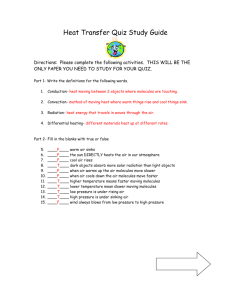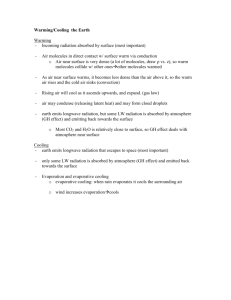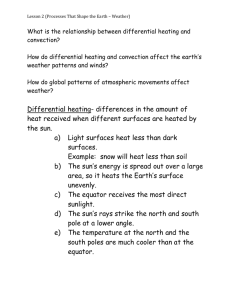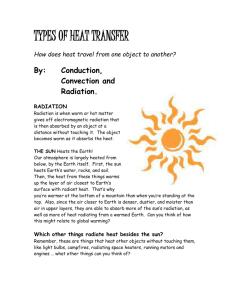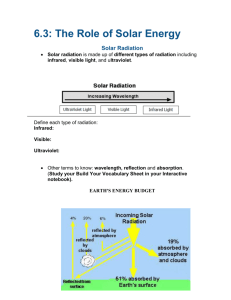PPTX format
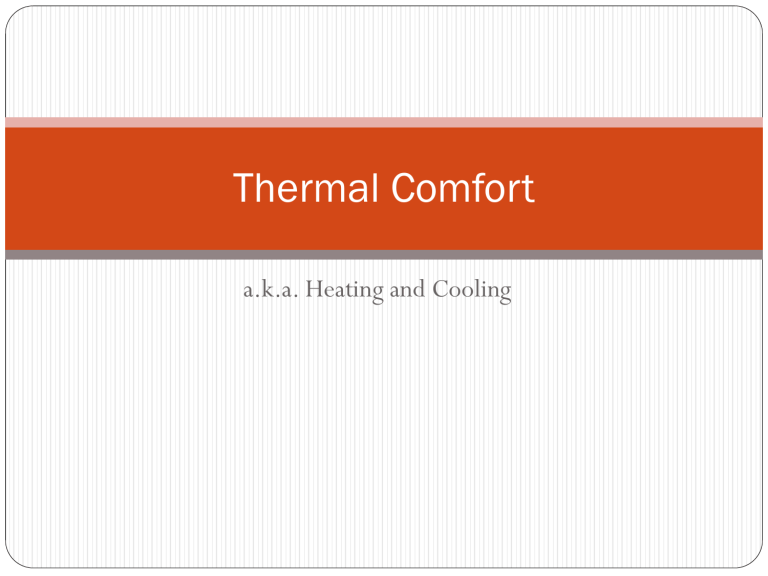
Thermal Comfort
a.k.a. Heating and Cooling
What is heat?
Heat is a form of energy
All matter has heat energy.
Heat is the excited motion of the atoms of a substance.
http://www.youtube.com/watch?v=f
1eAOygDP5s&feature=related
When a substance gets hot – it’s molecules disperse
Object when hot – expand
Objects when cold – contract http://www.youtube.com/watch?v=tPJLFDekxZA
Many implications in construction, e.g. concrete sidewalks
Sources of Heat
The sun
Earth interior
Heat produced when atoms are broken down (nuclear energy)
Friction
Conservation of Heat
1 st Law of Thermodynamics
energy is neither created nor destroyed in the conversion of heat to or from other forms of energy.
How Heat Travels
2 nd Law of Thermodynamics
When an object is at a different temperature from another body or its surroundings, heat flows so that the body and its surroundings reach the same temperature so that they are in thermal equilibrium.
History of Heat
Daniel Bernoulli
1700-1782 Swiss physician and mathematician
first proposed that gases consist of many molecules moving in all directions and that their impact on a surface causes the gas pressure.
Also proposed that the internal energy of a substance is the sum of the kinetic energy associated with each molecule
And proposed that heat transfer occurs from regions with energetic molecules, and so high internal energy, to those with less energetic molecules, and so lower internal energy.
James Joule
1818-1889 English physicist and brewer
Developed the first law of thermodynamics
(conservation of energy)
Developed Joule’s law (closely related to Ohm’s law) expressing the relationship between the heat generated by the current flowing through a conductor.
Q = I 2 * R * t
Q = heat
I = current
R = resistance t = time
The unit Joule is named after him. 1 Joule = the energy expended (or work done) in applying a force of one newton through a distance of one meter.
William Thomson, 1st Baron Kelvin
1824-1907 mathematical physicist and engineer
Discovered that there was a lower limit to temperature which he called “absolute zero.”
Based on laws of thermodynamics.
Absolute zero = temperature in which molecular movement stops.
Kelvin scale – measurement of thermodynamic temperature.
0 degrees Kelvin = −273.15 °C
How Heat Travels
Methods of Heat Transfer
Conduction – when a warm object touches a cool object – it’s heat will go to it
Convection – if a warm object sits in cool air – its heat will go off into the cool and rise as warm air.
Radiation – warm objects give off heat http://www.youtube.com/watch?v=SJKCO2XK3wM
Conduction
Transferring heat from molecule to molecule.
Metals are better conductors than heat than wood, glass or plastic.
Plastics are bad conductors of heat and are called insulators.
View video demo: http://www.youtube.com/watch?v=9Ux
U0ELgYOA&feature=related
Conduction Experiment
Why does a koozie work?
How does this concept relate to your home?
Convection
Process of a liquid or gas transmitting heat by means of the movement of heated matter.
Molecules when heated get excited and move farther away from one another, i.e. the substance expands and becomes less dense.
Convection
Molecules of warm air moves faster and disperse more quickly than cold air.
A gallon of cold air weighs more than a gallon of warm air
This is why hot air rises.
What is a convection current?
A convection current is a flow of a fluid or air due to heating and cooling of the fluid or air. Hot air rises. Cold air falls. If there is local heating of the air at some point, a convection current will be set up.
Convection experiments
http://www.youtube.com/watch?v=m232DHncGjk http://www.youtube.com/watch?v=07sNPZBgGv8&featur e=related
Radiation
Radiation is a method of heat transfer that does not rely upon any contact between the heat source and the heated object.
We feel heat from the sun even though we are not touching it.
Objects emit radiation when high energy electrons in a higher atomic level fall down to lower energy levels.
The energy lost is emitted as light or electromagnetic radiation.
Energy that is absorbed by an atom causes its electrons to "jump" up to higher energy levels.
Radiation
How do you control the amount of heat an object absorbs?
Materials with a dark or rough surface will absorb more infrared radiation than materials with a white or shiny surface.
Black cars get hotter than white cars. http://www.tom-morrow-land.com/tests/cartemp/index.htm
Quantifying Heat
How do we measure heat?
Heat is measured via temperature
Can be measured in Celsius, Fahrenheit or Kelvins.
How does a thermometer measure temperature?
A thermometer works because of the mercury. When mercury gets hot it expands and moves up the thermometer.
At what rate will an object warm up?
Specific heat is the amount of heat required to cause a unit of mass to change its temperature by 1°C.
The specific heat capacity of solid aluminum (0.904 J/g/°C) is different than the specific heat capacity of solid iron (0.449
J/g/°C). This means that it would require more heat to increase the temperature of a given mass of aluminum by 1°C compared to the amount of heat required to increase the temperature of the same mass of iron by 1°C. In fact, it would take about twice as much heat to increase the temperature of a sample of aluminum a given amount compared to the same temperature change of the same amount of iron.
This is because the specific heat capacity of aluminum is nearly twice the value of iron.
How do we measure heat energy it will take to warm something up?
Heat energy is measured in Joules: Q = m•C•ΔT
Q = Joules
M = mass
C = specific heat
Delta T = temp difference
What quantity of heat is required to raise the temperature of 450 grams of water from 15°C to
85°C? The specific heat capacity of water is 4.18
J/g/°C.
Q = m•C• Δ T = (450 g)•(4.18 J/g/°C)•(70.°C)
Q = 1.3x10
5 J = 130 kJ
Figure out the specific heat of an unknown metal
A 12.9 gram sample of an unknown metal at 26.5°C is placed in a Styrofoam cup containing 50.0 grams of water at
88.6°C. The water cools down and the metal warms up until thermal equilibrium is achieved at 87.1°C. Assuming all the heat lost by the water is gained by the metal and that the cup is perfectly insulated, determine the specific heat capacity of the unknown metal. The specific heat capacity of water is
4.18 J/g/°C.
See: http://www.physicsclassroom.com/class/thermalP/u18l2b.cfm
Creating Heating and Cooling in the
Home
Low Tech Options
Fire
Not very efficient.
Heat is lost through the chimney.
Heats through radiation.
Loses heat through convection
Low Tech Options
Fan
Simulates the “windchill effect”
Moving air increases convective heat loss – making it easier for sweat to evaporate from the skin.
Result: you feel cooler.
Heating Shelters
Electric Heaters
Electric current is forced through wires that have a lot of resistance.
Q = I 2 * R * t
Q – heat
I = current
R = resistance
t = time
Heating Shelters
Gas Heater
Takes in cold air cleans it with an air filter heats it up with a gas burner distributes the warm air with a blower motor through your home's ductwork
Heated air then cools down in your home's various rooms and returns to the furnace through return air grills and duct work.
Cooling Shelters
How air conditioners work
Works by drawing warm air out of the room.
Coils inside air conditioner contain freon – a material that absorbs heat when converting from a liquid to a gaseous state.
A compressor converts the freon back to liquid and expels the heat generated to the outside.
Repeated in a cycle to continue cooling.
http://www.youtube.com/watch?v=1MiQCBIx1mM
